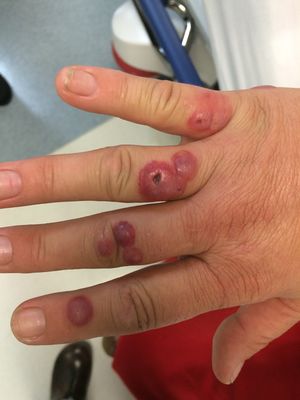We need you! Join our contributor community and become a WikEM editor through our open and transparent promotion process.
Bed bugs
From WikEM
Contents
Background
- Cimex lenticularis
- Bed bug bites are known as 'cimicosis'
- Bed bugs are attracted to CO2, warmth, exposed surfaces
- Tend to hide near beds, cracks, crevices
- Feed at night
- May appear translucent (nymphs,) brown (mature bug,) red (after meal,) black (after digestion)
- Belong to Hemiptera (like kissing bugs) which are vectors for trypanosomiasis (Central and South America)
Clinical Features
- Up to 20% of patients do not experience symptoms[1]
- Pain immediately after bite
- Erythematous papules, bullae, and wheals may take days to develop
- Classic line of bites: "breakfast, lunch, and dinner"
Differential Diagnosis
Ectoparasites
Evaluation
- Clinical diagnosis, based on history and physical exam.
Management
- Antihistamine for pruritus
- Consider topical steroids to decrease inflammation
- No evidence that medications improve outcomes
- Treat systemic reactions similar to anaphylaxis (rare)
- Self-limited 1-2 weeks without treatment
- Eradication using pesticides and other traditional approaches
Disposition
- Discharge if no evidence of systemic sx or anaphylaxis
See Also
External Links
References
- ↑ Jerome Goddard & Richard deShazo (2009). "Bed bugs (Cimex lectularius) and clinical consequences of their bites". Journal of the American Medical Association 301 (13): 1358–1366. PMID 19336711.
Authors
Amr Badawy, Ross Donaldson, Neil Young, Daniel Ostermayer, Michael Holtz


